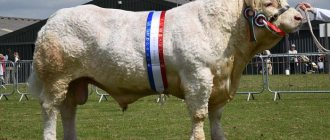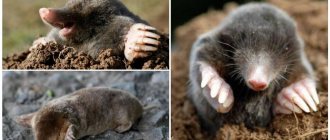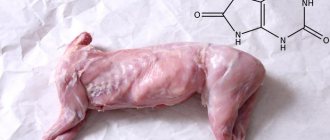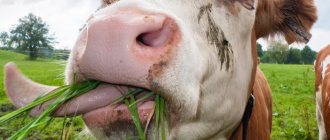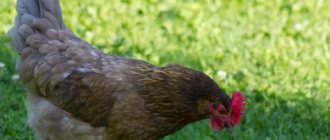Home » Articles about chickens » Dekalb chickens: description of the breed
Dekalb is a hybrid breed of chicken developed in the USA. Selection work was carried out by Dekalb Poltree Research. In the description presented by marketers, the laying hens of the new cross were referred to as “queen chickens.” Birds are characterized by high egg productivity.
Description of the hybrid breed
Currently, the main supplier of Dekalb chickens is the Dutch Animal Husbandry Institute, which merged with Dekalb Poultry Research in 2005. 2 lines are drawn: white and brown. They differ only in the color of their plumage - it can be white or brown. Work to improve the cross continues. The main goal of breeders is to extend the productivity period of laying hens.
Visually, Dekalbs are similar to other egg breeds - they are difficult to distinguish from Leghorns and Highsex. The body of the birds is lean, the bones are light, the body position of the roosters is vertical, the chest is convex. The legs are long, but not distinguished by developed muscles. Paws are yellow. The back is sloping and not wide. The wings are developed. The tail is narrow. The neck is short, the head is small, with a large hanging crest. The earlobes are white. The beak is small, yellowish-red. The eyes are dark.
History of cross breeding
Dekalb White appeared on the agricultural market relatively recently, but during its existence it managed to gain good authority among farmers of various types.
Did you know? Every year, the world's population eats about 567 billion chicken eggs. At the same time, German residents alone consume almost 16 billion eggs annually, which is an average of 200 eggs for every German
.
About a hundred years ago, when breeders of a well-known bird in the United States of America tried to convey information about the merits of their new development to the whole world, advertising specialists called these birds “the princesses of poultry farming.”
Over time, the promising slogan was fully justified - despite the youth of the breed, it quickly spread throughout the world and, moreover, occupied a leading position in egg productivity ratings. It was especially preferred by owners of large poultry production.
Today, developers continue to improve the positive qualities of the cross, focusing on increasing egg mass, and currently it is Dekalb chickens that give record levels of egg productivity.
Productive qualities
Dekalb chickens have modest meat productivity. The weight of roosters does not exceed 2 kg, chickens - 1.5-1.7 kg. The main advantage of dekalbs is the early onset of puberty and very high egg production. Chickens begin to lay eggs at 4.5-5 months. In industrial conditions, the deadline may come earlier - in 4 months. Chickens reach their maximum performance at 10 months. Throughout the year, laying hens lay up to 330-350 eggs. In pullets, the egg weight is 60-63 g; in mature birds it can be higher. The color of the shell depends on the color - in birds with dark plumage it is brown, in birds with light plumage it is white.
High productivity is explained by the lack of instinct to incubation. A decrease in indicators occurs only during molting, which occurs at 64-68 weeks. You can speed up this period by changing the lighting and feeding regime. Forced molting reduces the non-productive period to 45 days.
Diseases
The breed is prone to parasite damage. With an unbalanced diet (lack of nutrients), vitamin deficiency occurs, and outbreaks of cannibalism occur due to excess premixes.
- Parasites
- Infectious
- Other
Chicken mite
How to treat a chicken coop and how to treat a bird. Description of drugs and methods of control
Read
Coccidiosis
Thirst, loss of appetite, swelling, bloody droppings, anemia, weakness, poor coordination
Read
Ascariasis
Loss of appetite, liquid droppings, pale mucous membranes of the comb, limbs, ruffled plumage, lethargy, vomiting
Read
Amidostomiasis
Symptoms of the acute form: apathy, general weakness, decreased or lack of appetite, breathing problems, unsteady gait, retarded growth and development
Read
Prostagonymosis
Decreased mobility, loss of appetite, unsteady gait, bloating, fever, impaired egg laying, exhaustion
Read
Knemidocoptic mange (“lime foot”)
Acute symptoms: light gray bumps appear on the legs, the bird limps and stands on one leg, the cloaca and joints become inflamed, the beak is deformed
Read
Heteracidosis
Symptoms: indigestion, diarrhea, loss of appetite, lethargy, decreased egg production, retarded growth and development
Read
Trichomoniasis
Symptoms of the acute form: fever, depression and loss of appetite, diarrhea with gas bubbles and a putrid odor, enlarged goiter, difficulty breathing and swallowing
Read
Pullorosis (typhoid fever, salmonellosis)
Weakness, lack of coordination, drooping eyelids, difficulty breathing, lack of appetite, indigestion
Read
Colibacillosis
Lack of appetite, thirst, sudden increase in temperature, pale scallops, diarrhea
Read
Pasteurellosis
Fever, foamy mucus, change in stool color, refusal to feed, thirst, lethargy, wheezing, heavy breathing
Read
Marek's disease
Paralysis of the limbs, difficulty breathing, severe exhaustion and loss of strength, refusal of food and water, pallor of the scallop
Read
Gumboro disease
Diarrhea, loss of appetite, trembling legs and head, sudden death
Read
Laryngotracheitis
Weakness, swelling of the neck, difficulty breathing, cough, wheezing, blood clots in the mucus released when coughing, lack of appetite, indigestion
Read
Bird flu
Refusal to eat, anorexia, diarrhea, purulent discharge, hoarse breathing, greenish-brown droppings, seizures, darkening of the ridge
Read
Newcastle disease
Decreased appetite, fever, respiratory distress, immobility, conjunctivitis, bloody diarrhea
Read
Apteriosis
Complete or partial absence of plumage, loss of tail feathers, broken embryonic fuzz in young animals, delayed growth of plumage, pecking
Read
Pterophagy
Plucking and eating feathers. What is the reason, why does it require urgent intervention and how to prevent the disease?
Read
Yolk peritonitis
Symptoms of the acute form: loss of appetite, gray-green color of feces, sudden drop in egg production, calcareous deposits on the shell, bluish tint and baldness of the abdominal skin
Read
Cloacite
Symptoms: depressed state, decreased appetite, weight loss, increased need for water, loss of plumage, inflammation and bulging of the cloaca, the presence of ulcers on the mucous membrane, decreased egg production
Read
Content
In accordance with the description of the hybrid breed and reviews about it, Dekalb white and brown chickens can easily withstand space restrictions. They can be raised in cages or kept in free range poultry houses. Cage housing is practiced mainly in poultry farms. In private farms, dekalbs are kept in chicken coops with insulated walls. Based on 5 chickens, 1 square meter is enough. m. The floor can be concrete, wood or earthen. Bedding material is laid on top of it - sawdust, dry peat or straw are used. In winter, the thickness of the layer is increased.
Birds do not require additional heating. Due to the tight fit and the absence of cracks, the temperature in the room is maintained at a comfortable temperature for the chickens. To create a healthy microclimate, good ventilation is required. Ventilation through windows and doors leads to cooling of the room and the appearance of drafts. The supply and exhaust system is considered optimal in terms of efficiency and cost of arrangement.
Perches can be single-tiered or multi-tiered. To prevent chickens sitting on the top perch from contaminating the lower ones with excrement, the slats are arranged in the form of a ladder in 30 cm increments. The vertical distance between them is about 40 cm. To simplify cleaning, it is recommended to install a tray under the perches to collect excrement.
Manholes and a walking area are arranged on the south side. The size of the hole for dekalbs is 30x30 cm. To maintain the optimal length of daylight hours, light is provided into the chicken coop - incandescent lamps can be used. They provide air heating, which is an additional benefit in winter. Recommended duration is 14 hours. It is convenient to use automation to automatically turn on and off.
According to the description, Dekalb chickens are productive layers. Nests are installed in the poultry house - 1 for 3 chickens. They are placed above floor level to prevent hypothermia and to protect against rodents.
To clean their feathers, birds require a dry mixture of ash and sand. It is poured into troughs or other containers and installed indoors or in a walking area (under a canopy). The dry mixture is regularly changed with fresh mixture.
The walking area is fenced using a metal mesh. The height of the fence is at least 2 m. So that in summer the birds can hide from the sun or precipitation, it is recommended to install a canopy.
Character
Representatives of this species are characterized by the following features:
- Peacefulness.
- Calm character.
- Average activity.
These chickens almost never create conflicts in their flock. They also coexist peacefully with representatives of other breeds.
On farms they can live well in cages as they are not a highly active bird.
However, the character of this hybrid also has its flaws. Chickens adapt very poorly to new living conditions. If you move an adult chicken to a new coop, she will most likely become stressed. The chickens will get scared and cluck loudly, thereby creating problems for the owners.
Breeding
According to the description, Dekalb white and brown chickens are crosses. The offspring of hybrid breeds do not retain the characteristics of the parent generation, so there is no point in independent breeding. You will have to buy incubation material or chicks. The lack of maternal instinct in chickens will not allow them to be used as brood hens - an incubator will be required. Incubation duration is 3 weeks. 75-80% of chicks hatch from a laid clutch. The survival rate of young animals is very high – up to 100%.
Dried chickens are transferred to a brooder, where an optimal microclimate is maintained:
- high temperature (at the initial stage: +30°C);
- continuous illumination;
- moderate humidity (60-70%).
To make it easier to maintain hygiene, a mesh floor is installed, and a tray is placed underneath to collect excrement. At first, the chickens are fed 6 times a day, gradually the frequency of feedings is reduced. It is advisable to use ready-made complete feed - the norm for 1 chicken in the first 5 days is 15 g, gradually increasing. Pre-start feed with a high protein content can be replaced with a boiled egg, squeezed low-fat cottage cheese and cereal. In the first days, the chicks are given boiled water at room temperature.
Incubation
The lack of brooding instinct causes the young to be bred in an incubator or under laying hens of other breeds.
Eggs laid in no more than 5 days, without defects, are suitable for placing in the incubator. Preliminary disinfection with Ecocide or manganese solution is required. The incubation period is 20 days. In this case, overheating is not allowed.
Table of temperature and humidity modes
| Period |
